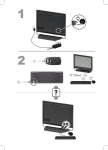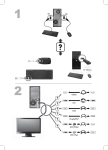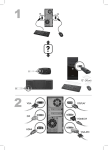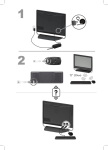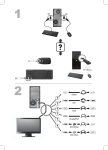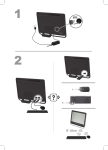Download HP QU156AAR#ABA User's Manual
Transcript
Getting Started Copyright and License The only warranties for Hewlett-Packard products and services are set forth in the express statements accompanying such products and services. Nothing herein should be construed as constituting an additional warranty. HP shall not be liable for technical or editorial errors or omissions contained herein. HP assumes no responsibility for the use or reliability of its software on equipment that is not furnished by HP. This document contains proprietary information that is protected by copyright. No part of this document may be photocopied, reproduced, or translated to another language without the prior written consent of HP. Hewlett-Packard Company P.O. Box 4010 Cupertino, CA 95015–4010 USA Copyright © 2011 Hewlett-Packard Development Company, L.P. This product incorporates copyright protection technology that is protected by U.S. patents and other intellectual property rights. Use of this copyright protection technology must be authorized by Macrovision, and is intended for home and other limited viewing uses only unless otherwise authorized by Macrovision. Reverse engineering or disassembly is prohibited. Microsoft and Windows 7 are U.S. registered trademarks of Microsoft Corporation. The Windows logo and Windows 7 are trademarks or registered trademarks of Microsoft Corporation in the United States and/or other countries/regions. "Dr. Dre", "Beats" and the B logo are trademarks of Dr. Dre and Jimmy Iovine. HP supports lawful use of technology and does not endorse or encourage the use of our products for purposes other than those permitted by copyright law. The information in this document is subject to change without notice. Understanding hard disk drive space The hard disk drive on the Hewlett-Packard and Compaq computers with the Microsoft® Windows operating system preinstalled may appear to be smaller than the size stated in the product specifications, in the documentation, or on the box. Hard disk drives are described and advertised by manufacturers in terms of decimal (base 10) capacity. Microsoft Windows and other programs, such as FDISK, use the binary (base 2) numbering system. In decimal notation, one megabyte (MB) is equal to 1,000,000 bytes, and one gigabyte (GB) is equal to 1,000,000,000 bytes. In the binary numbering system, one megabyte is equal to 1,048,576 bytes, and one gigabyte is equal to 1,073,741,824 bytes. Because of the different measuring systems, you may see a difference between the size reported by Microsoft Windows and the size advertised. The storage capacity of the hard disk drive is as advertised. Microsoft Windows reports smaller capacity in the Windows Explorer tool and in the computer window because it shows information about one partition on the hard disk drive at a time. One of the partitions contains the System Recovery information. Table of contents 1 Getting information ..................................................................................................... 1 2 Features ....................................................................................................................... 4 3 Setting up your computer .......................................................................................... 6 Protecting your computer ................................................................................ 6 Guidelines for installing software and hardware devices ................................ 7 Connecting to the Internet .............................................................................. 7 Transferring files and settings to your new computer ..................................... 9 Computer orientation .................................................................................... 10 Connecting a game console ......................................................................... 11 HP My Display TouchSmart Edition .............................................................. 13 Using Beats Audio™ ..................................................................................... 13 Using the HP TouchSmart with safety and comfort ...................................... 14 4 Troubleshooting and maintenance ......................................................................... 16 Computer does not start ............................................................................... 16 Power ............................................................................................................ 17 Display (screen) ............................................................................................ 17 Keyboard and mouse (with cable) ................................................................ 18 Keyboard and mouse (wireless) ................................................................... 20 Speakers and sound ..................................................................................... 21 Internet access ............................................................................................. 21 Gaming mode ............................................................................................... 22 Software troubleshooting .............................................................................. 23 Maintenance ................................................................................................. 26 System Recovery .......................................................................................... 28 Recovery media ............................................................................................ 32 ENWW iii iv ENWW 1 Getting information Type of information Where to find ● Set up your computer. Setup documentation included with your computer. ● See how-to videos about Visit www.hp.com/supportvideos (English only) using the features of your Tap the Tutorial icon (select models only) in the carousel within the HP computer. TouchSmart application. ● Use the computer. Getting Started (this guide) ● Connect to the Internet. ● Recover factory settings. ● Troubleshoot the most Help and Support: common computer hardware Tap the Start button, and then tap Help and Support. and software issues. ● Find links to driver updates. ● Read frequently asked questions. ● Learn how to use the Windows 7 troubleshooting tools: Microsoft® Windows® 7 1. operating system. ● Find Windows 7 support information. Tap the Start button, tap Control Panel, and then tap System and Security. 2. Under Action Center, tap Find and fix problems (troubleshooting). HP Support website: www.hp.com/support Visit www.hp.com/go/win7 ● Find electronic user guides HP Support website: www.hp.com/support and specifications for your computer model. ● Order parts and find additional troubleshooting help. ● Find computer warranty information. ● Limited Warranty and Support Guide or the Warranty and Support Information included with your computer. Get technical support. ENWW 1 Type of information Where to find ● www.hp.com/support/consumer-forum Get up-to-date information and help from the Windows community. ● Connect to a TV. Setup documentation included with your computer. Watching and Recording TV Tap the Start button, tap All Programs, and then tap User Guides. If the guide is not available there, visit www.hp.com/support ● ● Get special utilities for PC Help & Tools folder computer owners. Tap the Start button, tap All Programs, and then tap PC Help & Tools. Maintain your computer. HP Support Assistant — Maintains your computer performance and resolve problems faster by using automated updates, onboard diagnostics, and guided assistance. Tap the Start button, tap All Programs, tap HP, and then tap HP Support Assistant. ● Find ergonomic information. Safety & Comfort Guide Tap the Start button, tap All Programs, and then tap User Guides or visit www.hp.com/ergo. ● Wall-mounting your computer Wall-Mounting your HP TouchSmart (select HP TouchSmart PC Tap Start, tap All Programs, and then tap User Guides. models only). If the guide is not available there, visit www.hp.com/support WARNING! To reduce the risk of electrical shock or damage to your equipment: Place the computer in a location away from water, dust, moisture, and soot. These can increase the inside temperature, or can cause fire or electrocution. WARNING! Do not disable the power cord grounding plug. Plug the power cord in a grounded (earthed) outlet that is easily accessible at all times. WARNING! Disconnect power from the equipment by unplugging the power cord from the electrical outlet. WARNING! The power supply is preset for the country/region in which you purchased your computer. If you move, check the voltage requirements for your new location before plugging the computer into an AC power outlet. 2 Chapter 1 Getting information ENWW WARNING! To prevent direct exposure to a laser beam, do not try to open the enclosure of the CD or DVD drives. NOTE: Some features might not be available on systems that are shipped without a version of Microsoft Windows. ENWW 3 2 Features Features vary by model. The HP TouchSmart PC is a touch-enabled high-performance computer built into a high-definition widescreen display. The slim computer offers select features, that vary by model, such as an adjustable webcam, a CD/DVD and Blu-ray player and burner, Bluetooth capability, USB ports, a media card reader, Wireless 802.11n networking, full support for Beats Audio™ devices (sold separately), and high quality speakers. Select HP TouchSmart PC models can be mounted on a wall using a standard VESA wall-mounting device (purchased separately). HP TouchSmart 5.0 provides a unique, touch-based computer experience. Magic Canvas provides an interactive desktop that expands to the left and right, allowing you to spread out your applications and documents. Use the Carousel to place shortcuts to all of your favorite applications, folders, files, and Web pages. To launch the software, tap the HP TouchSmart icon on the desktop, or tap the Start button and then tap HP TouchSmart. ● The Magic Canvas The Magic Canvas is an interactive background that grows as you scroll to the left and right. You are no longer confined to one background screen, but can have notes, programs and files spread across the canvas, expanding to the left and right of the screen. ◦ Access a submenu, by tapping on the Magic Canvas, to change the background, write a note on the Magic Canvas and leave it there, and filter the media types that appear on your screen. ◦ Customize the appearance of your Magic Canvas with stationary and moving objects. ◦ Place playlists, slide shows, music, graffiti, videos, and photos on your Magic Canvas. ◦ A carousel, of available applications and your favorite website shortcuts, appears at the bottom of the screen. Make a left and right sliding motion with your finger over the carousel to scroll continuously through the applications and website shortcuts. ● Creating Magnets Magnets are content that you can place on the Magic Canvas. You can create magnets from some TouchSmart applications. ● 4 ◦ Drag content from an application (photos, music, playlists, notes, calendars) onto the Magic Canvas. ◦ Create shortcuts to content. ◦ Interact with magnets without having to open the application. ◦ Pin magnets to the Magic Canvas to prevent them from scrolling off. Interaction with Applications ◦ All active applications are highlighted in the carousel. ◦ Applications can be scrolled on or off the screen. ◦ Bring an application into view by touching it in the carousel. Chapter 2 Features ENWW ● ◦ View all applications and website shortcuts by tapping the Quick Launch button. ◦ Size application views to full screen, partial screen, or icon. Website Tiles Add shortcut tiles to your favorite websites into the carousel. For additional information about HP TouchSmart 5.0, tap the Start button, tap Help and Support, and then tap HP TouchSmart, or tap the Help and Support icon on the Carousel and then tap HP TouchSmart. ENWW 5 3 ❑ ❑ Setting up your computer Follow the steps in the setup documentation included with your computer. Place the computer so that all ventilation openings are unobstructed and cabling is not in a walkway or where it can be stepped on or damaged by placing furniture on it. ❑ Connect all power cords from the computer and accessories to a power surge protection device that is specifically labeled as having surge protection, an uninterruptible power supply (UPS), or a similar device. If the computer has a television tuner or telephone connection, protect the computer by using surge protection with these signal inputs as well. Connect the television cable or the telephone line cord to the surge protection device, and then connect the device to the computer. ❑ Download and install operating system updates. ❑ Look in the computer box for additional printed details or updates. ❑ Read the Safety and Regulatory Information document. Tap the Start button, tap All Programs, and then tap User Guides. ❑ Read the Safety & Comfort Guide for proper workstation setup, posture, health and work habits, and electrical and mechanical safety information. Tap the Start button, tap All Programs, and then tap User Guides or visit www.hp.com/ergo. Protecting your computer Computer risk Computer feature Unauthorized use of the User password computer or user account A password is a group of characters that you choose to secure computer information. Unauthorized access to Administrator password Setup Utility, BIOS settings, and other system identification information Computer viruses Antivirus software The free trial antivirus software that is preinstalled on your computer can detect most viruses, remove them, and, in most cases, repair damage caused by viruses. For protection against new viruses beyond the trial period, purchase an extended update service. 6 Chapter 3 Setting up your computer ENWW Computer risk Computer feature Unauthorized access to data Firewall software and ongoing threats to the ● Windows 7 includes firewall software preinstalled on the computer. ● The antivirus software, which is preinstalled on the computer, includes computer firewall software. Computer security Windows 7 critical security updates Microsoft continually updates the Windows 7 operating system. NOTE: Security solutions can deter theft, mishandling, and software attacks, but cannot prevent them. Guidelines for installing software and hardware devices After you complete the initial computer setup, you might want to install additional software programs or hardware devices. Check the operating system, memory, and other requirements listed before purchasing new software or hardware for your computer. Follow the software manufacturer's directions to install the new software. NOTE: Use only licensed original software. Installing copied software could result in an unstable installation, infect the computer with a virus, or be illegal. Connecting to the Internet Steps to connect to the Internet: 1. Connect the hardware (sold separately). ENWW Guidelines for installing software and hardware devices 7 ◦ For a wired network connection, connect an Ethernet cable to the computer and to a network router or LAN device. ◦ For a wireless network connection, use a wireless router with the computer to connect to a WLAN with an Internet connection. 2. 8 Get Internet service. Chapter 3 Setting up your computer ENWW ◦ Sign up with an Internet service provider (ISP). If you already have an account with an ISP, skip this step and follow the instructions provided by the ISP. ◦ If you did not set up the computer for Internet service during the initial setup, do so now by using Online Services: a. Tap the Start button, tap All Programs, and then tap Get Online. b. Follow the onscreen instructions to select an ISP and set up Internet service. NOTE: Online Services provides a list of ISPs; however, you might choose another ISP or transfer an existing account to this computer. To transfer existing accounts, follow the instructions provided by the ISP. 3. Using your Internet connection through your ISP, open a Web browser and browse the Internet. NOTE: If you have issues connecting to the Internet, see Internet access on page 21. Transferring files and settings to your new computer You can copy files from another computer to your new computer by using CDs or DVDs, memory sticks, and external hard drives. You can also use Windows Easy Transfer software, which is included with Windows 7 (select models only), to copy files and settings to a storage device or, using an Easy Transfer Cable, directly from another computer to the new computer. The Easy Transfer Cable is a USB cable designed specifically to connect two computers and to work with the Windows Easy Transfer software. NOTE: The Easy Transfer Cable is sold separately. A standard USB cable does not work. To transfer your files and settings: 1. Tap the Start button, type Windows Easy Transfer into the Start Search box, and then tap Windows Easy Transfer. 2. Follow the onscreen instructions in the Windows Easy Transfer wizard to transfer your files to your new computer. NOTE: Some features might not be available on systems that are shipped without a version of Microsoft Windows. ENWW Transferring files and settings to your new computer 9 Computer orientation Your HP TouchSmart PC can be tilted from the stand, within the range of –5 degrees to 30 degrees. If the computer is wall-mounted (select HP TouchSmart PC models only), it can be displayed in landscape orientation only. For instructions on wall-mounting your HP TouchSmart PC, refer to the Wall-Mounting your HP TouchSmart user guide. 10 Chapter 3 Setting up your computer ENWW Connecting a game console Select HP TouchSmart PC models only Some computer models allow you to use your system as a high-resolution monitor for gaming. An HDMI game console port is located on right side of the computer, at the bottom. You can get audio from the internal speakers, from headphones, or from external speakers connected to the A/V source connector (audio out) (1) located at the back of the computer. 1. Connect the game box cable to the HDMI port to enable onscreen display. 2. Connect the external speaker audio cable to the A/V source connector (1). 3. To switch between full screen mode and partial screen mode, tap the gaming image on the screen, or left click on the mouse. CAUTION: When the system is in display mode, the computer is still running in the background. The keyboard, mouse, and touch screen function are active and still control the computer. It is recommended that you save and close all files before connecting the game console ports. ENWW Connecting a game console 11 Using the remote control in gaming mode Use the A/V source button on your remote control to toggle between source modes: PC mode and gaming mode. If used while your are in gaming mode, the following buttons will still affect PC mode: ● A/V – Switches between sources (PC, HDMI) ● Volume – Affects the volume of the computer as well, when changed in gaming mode ● Mute – Mutes sound in games and on computer ● Media Center (Start) – Automatically switches back to computer and opens Media Center ● Power – Places the system into Sleep mode. Return to PC mode from gaming mode To return to PC mode from gaming mode, choose from any one of the following options: 12 ● Tap the full screen to return to desktop ● Press ESC key to return to desktop ● Left click mouse to return to desktop ● Press the Ctrl+Alt+Del buttons simultaneously on the keyboard ● Press the Power/Sleep button on the keyboard or remote ● Press the Power/Sleep button on the computer ● Press the Media Center (Start) button on the remote Chapter 3 Setting up your computer ENWW Adjusting settings with onscreen display (game console models only) HP TouchSmart PCs with the game console option include an onscreen display (OSD) button on the right side of the computer, just above the volume buttons. 1. Press the display menu button on the right side of the computer. The onscreen display menu opens, enabling you to select the display mode (default, movie, text, or gaming), adjust brightness and contrast, and make other display and sound adjustments. 2. The + and ‒ buttons below the display menu button enable you to scroll up and down through the menu choices. 3. After you select the features you want to customize, press the OK button underneath the display menu button. 4. When you are finished, you can close the Onscreen Display menu by clicking or tapping the red X in the upper right corner or pressing the display menu button at the side of the computer . NOTE: When connected to the game console port, your system is in display mode; there is no recording capability. HP My Display TouchSmart Edition Select HP TouchSmart PC models only HP My Display TouchSmart Edition allows you to adjust the screen display using the touch feature. ● You can adjust sound, brightness, and contrast. ● Viewing mode can be set to the factory default, or optimized for movie, text, or gaming. ● Status indicators let you know if the onscreen keyboard scroll lock, number lock, or caps lock are set. ● A settings screen lets you adjust color with the touch of a button. ● An options screen lets you set display options, set transparency, and check for updates. HP My Display TouchSmart Edition can be accessed from the task tray, or by right-clicking on the desktop, or from the Start Menu, tap All Programs, tap HP, and then tap HP My Display TouchSmart Edition. Online help for HP My Display TouchSmart Edition is available by tapping the ? button in the upper right hand corner of the application screen. Using Beats Audio™ Select HP TouchSmart PC models only ENWW HP My Display TouchSmart Edition 13 Your HP TouchSmart PC features audio connectors (headphone and Audio Out ) that are optimized for Beats Audio™ headphones and external audio systems (purchased separately). Select HP TouchSmart PC models also include four Beats-optimized internal speakers and a Beats toggle button on the keyboard. Your computer comes ready for you to experience music with Beats enabled. To disable Beats, press the Beats toggle button; the Beats-off icon appears on the screen. To turn Beats on, press the Beats toggle button again. If your keyboard does not contain the Beats toggle button, press Fn+B to enable and disable Beats. Tap the Beats icon on the system tray to view the Beats user interface. All you need to do is plug the Beats Audio headphones into the side headphone connector to experience crisp and clear sound separation. To experience the full capability of BEATS audio using the internal speakers, HP recommends connecting a matching HP subwoofer to the Sub connector on the back panel. If you are using an external audio system, plug it into the Audio Out connector on the back panel. Using the HP TouchSmart with safety and comfort Before you begin using the computer, arrange the computer and your work area to maintain your comfort and productivity. Refer to the Safety & Comfort Guide for important ergonomic information: Visit www.hp.com/ergo on the Web. WARNING! To reduce the risk of serious injury, read the Safety & Comfort Guide. It describes proper computer setup, posture, and health and work habits for computer users. It also provides important electrical and mechanical safety information. 14 Chapter 3 Setting up your computer ENWW Locate the HP TouchSmart PC in the room to minimize glare from the screen. You can also reduce glare by tilting the screen. The HP TouchSmart screen can be used as an input device; therefore, the computer should be placed so that your shoulders and neck are comfortable. The computer might need to be moved close to your body to keep your shoulders relaxed while you are touching the screen. Keep your shoulders low and your upper arm close to your body when you touch the screen. The more the screen is used for input, the more important this is. You can position the computer in a variety of ways to provide a balance between relaxing your shoulders and keeping your head balanced comfortably over your neck. If you feel discomfort in your shoulders, try moving the computer closer to your body or lowering the height of the screen by lowering the work surface. If you feel discomfort in your upper back muscles and neck, try increasing the height of the screen by increasing the work surface height. The graphic below shows correct body and computer positioning. The graphic below shows incorrect usage. ENWW Using the HP TouchSmart with safety and comfort 15 4 Troubleshooting and maintenance Refer to the documentation provided by the product manufacturer for information about peripheral-specific problems, such as issues with a printer. The following sections present some issues you might encounter while installing, starting up, or using your computer and possible solutions. For more information or for additional troubleshooting options, see Getting information on page 1. Computer does not start Symptom Possible solution Error message: Contact Support: www.hp.com/support Hard disk drive error. Computer will not Ensure that the cables connecting the computer to the external power source are plugged turn on or start. in properly. When the cables connecting the computer to the external power source are plugged in properly, and the wall outlet is functioning, the green power supply light on the back of the computer should be on; if it is not, contact Support. If the display (screen) is blank, the computer might not be properly connected. Plug in the computer and turn it on. Test the wall outlet by connecting a different electrical device to it. Computer seems Use the Windows Task Manager to close any programs not responding, or restart the to be locked up computer: and is not responding. 1. Press the Ctrl+Alt+Delete keys on the keyboard simultaneously. 2. Tap Start Task Manager. 3. Tap the program that is not responding, and then tap End Task. If closing programs does not work, restart the computer: 1. Press the Ctrl+Alt+Delete keys on the keyboard simultaneously. 2. Tap the Arrow button next to the red Shut Down button, and then tap Restart. Or, press and hold the Power button on the computer for 5 or more seconds to turn off the computer, and then press the Power button to restart the computer. 16 Chapter 4 Troubleshooting and maintenance ENWW Power Symptom Possible solution Error message: When drive activity stops, remove the disc, and then press the spacebar on the keyboard. Invalid system The computer should start up. disk or NonSystem disk or Disk error. Computer does Press and hold the Power button until the computer turns off. Check Power Settings. not turn off when the Power button is pressed. Computer shuts ● The computer might be in an exceedingly hot environment. Let it cool down. down ● Ensure that computer air vents are not blocked and that the internal fan is running — automatically. see Keeping the computer free of dust, dirt, and heat on page 27. (Your computer might not have an internal fan.) Display (screen) Symptom Possible solution Screen is blank. Reconnect the power plug to the back of the computer and to the wall outlet. Press the Power button to turn on the computer. Press the space bar on the keyboard or move the mouse to make the screen display visible again. Press the Sleep button (select models only), or the Esc key on the keyboard, to resume from Sleep mode. Images on the Adjust the display resolution setting in Windows 7: screen are too 1. Tap the Start button, and then tap Control Panel. 2. Under Appearance and Personalization, tap Adjust Screen Resolution. 3. Adjust resolution as necessary, and then tap Apply. large or too small, or the images are fuzzy. ENWW Power 17 Keyboard and mouse (with cable) Symptom Possible solution Keyboard Use the mouse to turn off the computer, unplug and reconnect the keyboard to the back of commands and your computer, and then restart your computer. typing are not recognized by the computer. Mouse (with Unplug and reconnect the mouse cable to your computer. cable) does not work or is not If the mouse is still not detected, turn off the computer, unplug and reconnect the mouse detected. cable, and then restart the computer. Cursor does not Press Num Lock on the keyboard to turn off Num Lock, so that the arrow keys on the move using the number keypad can be used. arrow keys on the number keypad. Cursor does not Use the keyboard to save changes in all open programs, and then restart your computer: respond to mouse 1. Press the Alt+Tab keys simultaneously to navigate to an open program. 2. Press the Ctrl + S key simultaneously to save your changes in the selected program movement. (Ctrl + S is the keyboard shortcut for Save on most—not all—programs). 3. Repeat step 1 and step 2 to save changes in all open programs. 4. After saving changes in all open programs, press the Ctrl+Esc keys on the keyboard simultaneously to display the Windows Start menu. 5. Use the arrow keys to select the Arrow button that is next to Shut Down. Select Shut Down, and then press Enter. 6. After the shutdown is complete, unplug and reconnect the mouse connector to the back of your computer, and then restart your computer. 18 Chapter 4 Troubleshooting and maintenance ENWW Symptom Possible solution Cursor responds For a mouse with a roller ball: slowly, moves ● only vertically or counterclockwise), remove the ball, and clean it by using a damp, lint-free cloth (not horizontally, or does not track smoothly. Clean the roller ball: Remove the roller ball cover from bottom of mouse (rotate it paper). Also clean the rollers on which the ball moves. ● Use a mouse pad or other rough surface under the mouse. For an optical mouse: ● Clean the optical mouse: Gently wipe the light sensor lens on the bottom of the mouse by using a lint-free cloth (not paper). ● Use a mouse pad, white sheet of paper, or other less reflective surface under the mouse. ENWW Keyboard and mouse (with cable) 19 Keyboard and mouse (wireless) Symptom Possible solution Wireless ● during initial setup or for re-synchronization. mouse does not work or is Ensure that you are using the wireless keyboard or wireless mouse within range of the receiver, approximately 10 meters (32 feet) for normal use, and within 30 cm (12 inches) keyboard or ● not detected. Ensure that the mouse is not in Suspend mode, which occurs after 20 minutes of inactivity. Tap the left mouse button to reactivate it. ● Replace the batteries in the keyboard and mouse. ● Re-synchronize the keyboard and mouse to the receiver using the following steps. The receiver, wireless keyboard, and wireless mouse shown in the following illustrations are examples; your models might vary. IMPORTANT: During these steps, place the wireless keyboard and wireless mouse on the same level as the receiver, within 30 cm (12 inches) of the receiver, and away from interference from other devices. 1. Unplug the receiver from the USB connector on the computer, and then reconnect it. Your computer model might have a connector dedicated to the receiver. 2. Check that the mouse is on (1), and then push and hold the Connect button (2) on the underside of the mouse for 5 to 10 seconds until the LED on the receiver lights or stops flashing. The receiver connection session times out after 60 seconds. To ensure that the connection was established, and that the receiver did not time out instead, and then move the mouse and check for a response on the screen. 3. After the mouse connection is established, continue by using the following steps to repeat the procedure for the keyboard. 4. Push and hold the Connect button (1) on the underside of the keyboard for 5 to 10 seconds until the LED on the receiver lights or stops flashing. 20 Chapter 4 Troubleshooting and maintenance ENWW Speakers and sound Symptom Possible solution Volume is very Ensure that you connected the speakers to the Audio Out connector on the back of the low or computer. (Additional audio connectors are used for multiple-channel speakers.) Detached unsatisfactory. non-powered speakers (speakers without a separate power source, such as batteries or a power cord) do not produce satisfactory sound. Replace the non-powered speakers with powered speakers. No sound is For Windows 7: produced. 1. Tap the Start button, tap Control Panel, tap Action Center, and then tap Troubleshooting. 2. Under Hardware and Sound, tap Troubleshoot and audio playback. If you are using built-in computer speakers, use the Volume button to adjust volume. You can also use My Display TouchSmart Edition to ensure that the volume is set appropriately. Ensure that you connected powered (active) speakers and that they are turned on. Turn off your computer, and then unplug and reconnect the speakers. Ensure that the speakers are connected to an audio connector, not a Line In or headphone connector. To resume from Sleep mode, press the Sleep button (select models only), or press Esc. Unplug headphones if they are connected to your computer (or speaker system). When external When an Audio Line Out connector (such as headphones or external speakers) is speakers are connected, the internal speakers are muted. connected, the audio is muted. Internet access Symptom Possible solution Internet programs Log in to your Internet Service Provider (ISP), and start the desired program. do not start automatically. ENWW Speakers and sound 21 Symptom Possible solution Cannot connect to For Windows 7: the Internet. 1. Tap the Start button, tap Control Panel, tap Action Center, and then tap Troubleshooting. 2. Under Network and Internet, tap Connect to the Internet. Verify that you are using the proper cables for your Internet connection type. Your computer might have an Ethernet network adapter (also called a network interface card, or NIC). The network adapter uses a network cable, to connect to a local area network (LAN). Do not connect a telephone cable to the network adapter, and do not plug a network cable into a telephone service line; doing so might damage the network adapter. Run the wireless setup wizard: 1. Tap the Start button, tap Control Panel, tap Network and Internet, and then tap Network and Sharing Center. 2. In the Network and Sharing Center window, tap Set up a connection or network to open the wizard, and then follow the onscreen instructions. If your system has an external antenna, try to move the antenna to a better position. If the antenna is internal, try to move the computer. Try to connect again later, or contact your ISP for assistance. Gaming mode Symptom Possible Solution When connecting ● Ensure that the gaming device and the computer are on. the gaming device to the game console port, the computer keeps going back to PC mode. 22 Chapter 4 Troubleshooting and maintenance ENWW Symptom Possible Solution No Signal ● Ensure that the gaming device is on. message appears ● Make sure the HDMI cable is connected from the gaming device to the computer. on the display. Audio drops when ● being played. The system is on Mute. Press the Volume + or Volume – button on the side of the computer to get out of Mute state. a video game is ● Check the volume setting on the Onscreen Display menu. ● Open the Audio Settings menu from within the gaming application to ensure that the correct audio format output is selected. Choose Digital Stereo, or PCM Audio. (HP TouchSmart PC does not support AC3, DTS, Dolby Digital 5.1.) Software troubleshooting Some software repairs are as simple as restarting your computer, and others require performing a System Recovery from files on your hard disk drive. To repair software problems, try these methods: ● Turn the computer off completely, and then turn it on again. Sometimes this is the easiest way to fix a problem. ● Update the drivers (see Updating drivers on page 23). ● Use Microsoft System Restore (see Microsoft System Restore on page 24) — Restore your computer to ● Reinstall the software program or hardware driver. (See Software program and hardware driver a configuration that was in use before the software was installed. reinstallation on page 25) — Restores the software (if it came with the product) or hardware driver to factory defaults. ● System Recovery (see System Recovery on page 28) — Erase and reformat the hard disk drive, and then reinstall the operating system, programs, and drivers. CAUTION: This erases all data files you have created. Updating drivers A driver is a software program that enables your computer to communicate with an attached device, such as a printer, hard disk drive, mouse, or keyboard. ENWW Software troubleshooting 23 Complete the following procedure to update a driver, or to revert to an earlier version of the driver if the new one does not solve your problem: 1. Tap the Start button. 2. Type Device Manager into the Start Search box, and then tap Device Manager to open the Device Manager window. 3. Tap the plus sign (+) to expand the type of device you want to update or rollback. (For example, DVD/CDROM drives). 4. Double-tap the specific item (for example, HP DVD Writer 640b). 5. Tap the Driver tab. 6. To update a driver, tap Update Driver, and then follow the onscreen instructions. Or, to revert to an earlier version of a driver, tap Rollback Driver, and then follow the onscreen instructions. You can also go to the HP Support website: www.hp.com/support and select the task, Download drivers and software. Follow the onscreen instructions. Microsoft System Restore If you have a problem that might be due to software that was installed on your computer, use System Restore to return the computer to a previous restore point. You can also set restore points manually. NOTE: Always use this System Restore procedure before you use the System Recovery program. NOTE: Some features might not be available on systems that are shipped without a version of Microsoft Windows. To start a System Restore: 24 1. Close all open programs. 2. Tap the Start button, tap Computer, and then tap Properties. 3. Tap System protection, System Restore, tap Next, and then follow the onscreen instructions. Chapter 4 Troubleshooting and maintenance ENWW To add restore points manually: 1. Close all open programs. 2. Tap the Start button, tap Computer, tap Properties, and then tap System protection. 3. Under Protection Settings, tap the disk for which you want to create a restore point. 4. Tap Create, and then follow the onscreen instructions. Software program and hardware driver reinstallation If any of your factory-installed software programs or hardware drivers are damaged, you can reinstall it by using the Recovery Manager program (select models only). NOTE: Do not use the Recovery Manager program to reinstall software programs that came on CDs or DVDs included in the computer box. Reinstall these programs directly from the CDs or DVDs. Before you uninstall a program, ensure that you have a way to reinstall it. Make sure that the program is still available from where you initially installed it (for example, discs or the Internet). Or verify that the program is in the list of programs you can reinstall from the Recovery Manager. NOTE: Some features might not be available on systems that are shipped without a version of Microsoft Windows. To check the list of installable programs in the Recovery Manager: 1. Tap the Start button, tap All Programs, tap Recovery Manager, and then tap Recovery Manager. If prompted, tap Yes to allow the program to continue. 2. Under I need help immediately, tap Software Program Reinstallation. 3. Tap Next at the Welcome screen. A list of programs opens. Check whether your program is there. To uninstall a program: 1. Close all software programs and folders. 2. Uninstall the damaged program: a. Tap the Start button, and then tap Control Panel. b. Under Programs, tap Uninstall a program. c. Tap the program you want to remove, and then tap Uninstall. d. Tap Yes if you want to continue with the uninstall process. ENWW Software troubleshooting 25 To reinstall a program using the Recovery Manager: 1. Tap the Start button, tap All Programs, tap Recovery Manager, and then tap Recovery Manager. 2. Tap Software Program Reinstallation, and then tap Next at the Welcome screen. 3. Choose the program you want to install, tap Next, and follow the onscreen instructions. 4. When you have finished reinstalling, restart the computer. Do not skip this last step. You must restart the computer after recovering software programs or hardware drivers. Maintenance It is important that you perform simple maintenance of your computer to ensure that it works at peak performance. Weekly Software cleanup Use Disk Cleanup or safe third-party cleaning tools to remove junk files and temporary files that accumulate and slow down your system. Also, check for programs you no longer need and uninstall them. Defragmentation Run Disk Defragmenter to keep your hard disk in good condition and improve system performance. Frequently performing this task does not harm your system. Virus scan Perform a full virus scan every week to catch viruses that might have slipped through unnoticed. Most antivirus products have a scheduling feature to keep track of this automatically. Monthly Hardware cleanup Thoroughly clean the outside of your computer. Software updates Use Windows Updates to fix operating system bugs and improve performance. Also, be sure to check for driver updates for your hardware and new versions of your favorite programs. Windows Update Hard disk diagnostic Run Windows Update monthly to install updates. Sometimes a failing hard disk can be caught beforehand by using Hard Disk Diagnostic. Yearly 26 Chapter 4 Troubleshooting and maintenance ENWW System Recovery In time, your system might still get bogged down, depending on the computer usage. Use System Recovery to wipe your Windows operating system installation clean, restoring it to the original configuration when you first started your system. Make a backup of important data files before proceeding with a System Recovery. See System Recovery on page 28 for further details. As needed Backing up your data Use CD or DVD recording software that is installed on your computer to create (or “burn”) backup discs of important information, including personal files, e-mail messages, and website bookmarks. You can also move data to an external hard disk drive. Keeping the computer free of dust, dirt, and heat Keeping your computer system free of dust, dirt, and heat will prolong its life. Dust, pet hair, and other particles can build up, creating a blanket effect; as a result, components can overheat, or, in the case of the keyboard and mouse, not work smoothly and effectively. Check your system once a month for visible signs of dust and debris, and clean it about once every three months. Visit www.hp.com/support for additional cleaning instructions. Cleaning the computer Air vents keep the computer cool. Keep these vents clean by using a small, vents battery-powered vacuum cleaner. (A battery-powered vacuum cleaner eliminates the risk of electric shock.) 1. Vacuum the vents on the computer case. 2. Remove any debris that has accumulated in and around the computer connectors (for example, the Ethernet and USB connectors). ENWW Maintenance 27 Cleaning the keyboard and When cleaning the keyboard keys, use a low setting on a battery-powered vacuum mouse cleaner, to avoid removing key caps and springs. 1. Vacuum between the keys of the keyboard and along the grooves. 2. Use a clean, dry cloth and isopropyl (rubbing) alcohol to clean buildup on the keyboard keys and along its edges. 3. Wipe the body of the mouse and the mouse cord by using cleaning wipes. If you have a roller-ball mouse, clean the ball and rollers inside: 1. Turn the mouse upside down, and rotate the ball-cover ring counterclockwise to remove the ring and release the roller ball. 2. Rinse the roller ball with soap and warm water. 3. Clean the rollers inside the mouse with a cotton swab dampened with isopropyl (rubbing) alcohol. 4. After the roller ball and rollers are completely dry, replace the ball and ballcover ring. Cleaning the touch screen Follow these steps to clean the touch screen: 1. Turn off the computer. Tap the Start button, and then tap Shut Down. 2. Disconnect the power cord from the wall. 3. Spray a small amount of mild glass cleaner on a soft cloth to clean the touch screen. 4. Wipe the surface and left and right side of the touch screen to remove any dirt, fingerprints, or other debris that could hinder the touch recognition of the screen. CAUTION: Do not spray or place the cleaner directly on the screen; spray the cleaner into the cloth, and then wipe the sides and surface of the touch screen. Do not use an abrasive cleaner or cloth when cleaning the sides or the surface of the screen, because this could cause damage to the touch screen. System Recovery System Recovery completely erases and reformats the hard disk drive, deleting all data files you have created, and then reinstalls the operating system, programs, and drivers. However, you must reinstall any software that was not installed on the computer at the factory. This includes software that came on media included in the computer accessory box, and any software programs you installed after purchase. NOTE: Always use the System Restore procedure before you use the System Recovery program — see Microsoft System Restore on page 24. 28 Chapter 4 Troubleshooting and maintenance ENWW NOTE: Some features might not be available on systems that are shipped without a version of Microsoft Windows. You must choose one of the following methods to perform a System Recovery: ● Recovery Image — Run the System Recovery from a recovery image stored on your hard disk drive. The recovery image is a file that contains a copy of the original factory-shipped software. To perform a System Recovery from a recovery image, see System Recovery from the Windows 7 Start Menu on page 29. NOTE: The recovery image uses a portion of the hard disk drive that cannot be used for data storage. ● Recovery Media — Run the System Recovery from recovery media, that you created from files stored on your hard disk drive, or purchased separately. To create recovery media, see Recovery media on page 32. System Recovery options You should attempt a System Recovery in the following order: 1. Through the hard disk drive, from the Windows 7 Start menu. 2. Through the hard disk drive, by pressing the F11 key on the keyboard during system startup. 3. Through recovery media that you create. 4. Through recovery discs purchased from HP Support. To purchase recovery discs, visit www.hp.com/ support. System Recovery from the Windows 7 Start Menu CAUTION: System Recovery deletes all data and programs you created or installed. Back up any important data to a removable disc or USB flash drive. ENWW System Recovery 29 If the computer is working and Windows 7 is responding, use these steps to perform a System Recovery. 1. Turn off the computer. 2. Disconnect all peripheral devices from the computer except the keyboard and mouse. 3. Turn on the computer. 4. Tap the Start button, tap All Programs, tap Recovery Manager, and then tap Recovery Manager. If prompted, tap Yes to allow the program to continue. 5. 6. Under I need help immediately, tap System Recovery. Tap Yes, and then tap Next. Your computer restarts. NOTE: If your system does not detect a recovery partition, it prompts you to insert recovery media. Insert the disc, or USB flash drive, tap Yes, and then tap Next to restart the computer and run Recovery Manager from the recovery disc, or the recovery USB flash drive. If using discs, insert the next system-recovery disc when prompted. 7. When the computer restarts, you will see the Recovery Manager welcome screen again. Under I need help immediately, tap System Recovery. If you are prompted to back up your files, and you have not done so, tap Back up your files first (recommended), and then tap Next. Otherwise, tap Recover without backing up your files, and then tap Next. 8. System Recovery begins. After System Recovery is complete, tap Finish to restart the computer. 9. Complete the registration process, and wait until you see the desktop. 10. Turn off the computer, reconnect all peripheral devices, and turn the computer back on. System Recovery at system startup CAUTION: System Recovery deletes all data and programs you created or installed. Back up any important data to a removable disc. 30 Chapter 4 Troubleshooting and maintenance ENWW If Windows 7 is not responding, but the computer is working, follow these steps to perform a System Recovery. 1. Turn off the computer. If necessary, press and hold the Power button until the computer turns off. 2. Disconnect all peripheral devices from the computer, except the keyboard and mouse. 3. Press the Power button to turn on the computer. 4. As soon as you see the initial company logo screen appear, repeatedly press the F11 key on your 5. Under I need help immediately, tap System Recovery. keyboard until the Windows is Loading Files… message appears on the screen. 6. If you are prompted to back up your files, and you have not done so, tap Back up your files first (recommended), and then tap Next. Otherwise, tap Recover without backing up your files, and then tap Next. 7. System Recovery begins. After System Recovery is complete, tap Finish to restart the computer. 8. Complete the registration process, and wait until you see the desktop. 9. Turn off the computer, reconnect all peripheral devices, and turn the computer back on. System Recovery from recovery media CAUTION: System Recovery deletes all data and programs you created or installed. Back up any important data to a removable disc, or USB flash drive. To create recovery media, see Recovery media on page 32. ENWW System Recovery 31 To perform a System Recovery using recovery media: 1. If the computer is working, create a backup DVD, or backup USB flash drive, containing all the data files you want to save, and then remove the backup media from the computer. 2. Insert recovery disc #1 into the DVD drive tray, and close the tray; or if using a recovery USB flash drive, insert it into a USB port. 3. If the computer works, tap the Start button, and then tap Shut Down. Or, if the computer is not responding, press and hold the Power button for approximately 5 seconds, or until the computer turns off. 4. 5. Disconnect all peripheral devices from the computer except the keyboard and mouse. Press the Power button to turn on the computer. If you are using a recovery DVD, the computer will automatically run Recovery Manager from the disc. Skip to step 7. 6. If you are running System Recovery from a USB flash drive, press the Esc key as the computer is powering on to bring up the boot menu. Use the arrow keys to select the USB device and press Enter to boot from that device. 7. If the Recovery Manager asks if you want to run System Recovery from Media or Hard Drive, select Media. On the Welcome screen, under I need help immediately, tap Factory Reset. 8. If you are prompted to back up your files, and you have not done so, tap Back up your files first (recommended), and then tap Next. Otherwise, tap Recover without backing up your files, and then tap Next. 9. If you are prompted to insert the next recovery disc, do so. 10. When the Recovery Manager is finished, remove all recovery discs, or the recovery USB flash drive, from the system. 11. Tap Finish to restart the computer. Recovery media Recovery media can be created on either blank DVD discs or a USB flash drive (one or the other, but not both). Create recovery media from the recovery image stored on your hard disk drive. This image contains the operating system and software program files that were originally installed on your computer at the factory. You can create only one set of recovery media for your computer; the recovery media can be used only with this computer. Store the recovery media in a safe place. NOTE: Some features might not be available on systems that are shipped without a version of Microsoft Windows. 32 Chapter 4 Troubleshooting and maintenance ENWW Choosing recovery media ● To create recovery discs, your computer must have a DVD writer, and you must use only high-quality blank DVD+R or DVD-R discs. NOTE: You cannot use CDs or DVD+RW, DVD-RW, DVD+RW DL, DVD-RW DL, DVD+R DL, or DVD-R DL discs to create recovery discs. ● ● You have the option of creating a recovery USB flash drive instead, using a high-quality blank USB drive. If you are creating recovery discs, be sure to use high-quality discs. It is normal for discs to be rejected if they are not defect-free. You will be prompted to insert a new blank disc to try again. ● The number of discs in the recovery-disc set depends on your computer model (typically 3–6 DVD discs). The Recovery Media Creation program tells you the specific number of blank discs needed to make the set. If you are using a USB flash drive, the program will tell you the size of the drive required to store all the data (minimum of 8 GB). NOTE: The process of creating recovery media takes some time to verify that the information written on the media is correct. You can quit the process at any time. The next time you run the program, it resumes where it left off. Creating recovery media To create recovery discs: 1. Close all open programs. 2. Tap the Start button, tap All Programs, tap Recovery Manager, and then tap Recovery Media Creation. If prompted, tap Yes to allow the program to continue. 3. Tap Create recovery media using blank DVD(s), and then tap Next. 4. Follow the onscreen instructions. Label each disc as you make it (for example, Recovery 1, Recovery 2). To create a recovery USB flash drive: 1. Close all open programs. 2. Insert the USB flash drive into a USB port on the computer. 3. Tap the Start button, tap All Programs, tap Recovery Manager, and then tap Recovery Media Creation. 4. Tap Create recovery media with a USB flash drive, and then tap Next. 5. Select the USB flash drive from the list of media. The program will let you know how much storage is required to create the recovery drive. If the USB flash drive does not have enough storage capacity (8 GB is the minimum), it will be grayed out on the screen. Tap Next. NOTE: Recovery Media Creation formats the flash drive and deletes all on files on it. 6. Follow the onscreen instructions. Make sure to label the USB flash drive and store it in a secure place. NOTE: Do not use media cards for creating recovery media. The system may not be able to boot up from a media card and you may not be able to run system recovery. ENWW Recovery media 33 The power to make a change Thank you for your purchase. HP is dedicated to producing the highest quality, best performing, and easiest to use computers in the world. HP also designed this product with the environment in mind. But to reduce its impact even further, we need your help. Let’s work together to make a change. How you can help What we do Recycle your old computer. We design with the environment in mind. Disposing of electronic waste responsibly has been an HP priority for more than 20 years. If this computer is a replacement for an older computer you no longer need, go to www.hp.com/go/recycle to find out if HP can help you dispose of your old computer with minimum impact on the planet. While we want you to enjoy this computer for many years to come, we recognize that you will eventually dispose of it. We have designed it so it can be easily dismantled and recycled as much as possible. The packaging that came with your computer is also designed for maximum recyclability. Don't use a screen saver. We design to be more energy efficient. Screen savers can prevent your HP computer from going to sleep and thereby waste power. Screen savers can also reduce the life of your monitor by increasing the number of hours the LCD backlight is on. This computer has HP Power Management Technology, which can reduce computer energy use up to 45% compared to computers without power management. HP computers keep energy needs to a minimum, saving you money and reducing your carbon footprint. Don't disable the power settings. We design our products to use better and fewer materials. The power management tools on this computer are set to minimize energy use without impacting performance. Please do not disable them. Printed in Ensuring the health of you, your family, and our planet is a key priority at HP. We are committed to using the safest materials in the production of this and all our other products.










































